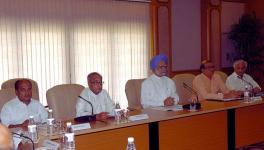Union Budget: Govt. Apathy Continues in Spendings Concerning Social Sectors
Image for representational use only.Image Courtesy : The Hindu
The Union Budget 2019-20 presented by Finance Minister Nirmala Sitharaman on Friday, July 5, reinstates the Bharatiya Janata Party government’s reluctance in expanding its economic activities in crucial sectors including health and education that concerns the majority population. An analysis of the budget figures reveals a disappointing pattern in the BJP government’s performance in the last five years, as the public spendings through ministries concerning social sector have worsened.
While the budget completely missed out the ruling party’s manifesto in the recent Lok Sabha elections, experts argue that its fiscal targets are unrealistic considering the slowing down of economy. For instance, as far as the government’s target to become a $5 trillion economy in five years is concerned, experts estimate that the annual gross domestic product (GDP) growth rate has to reach 17% by 2024. However, the GDP growth has been falling over the years and the latest quarterly growth rate is at 5.8% according to official data. Also, this is at a time when the credibility of the government’s growth figures are under question over controversial methodologies of calculations brought in by the BJP government.
Here is a look at the government spending through several crucial ministries as a percentage of GDP.
Chart 1: Ministry Expenditure as a percentage of GDP
As can be seen from the above chart, except for Agriculture Ministry; the Ministry of Rural Development; Ministry of Health and Family Welfare and the Ministry of Human Resource Development, the government spending as a percentage of GDP has plateaued or fallen over years. Even the sudden jump in the Agriculture Ministry’s spending (total allocation is Rs 1,30,485 crore) from the revised estimate for last year which is Rs. 67,800 is primarily because of the Pradhan Mantri- Kisan Samman Nidhi (PM-KISAN) scheme launched just before the elections under which Rs. 6,000 would be given to all small and marginal farmers as income support. However, this policy alone couldn’t address the acute rural distress. Agriculture Ministry’s expenditure as a percentage of GDP has seen an increase from 0.410 % in 2018-19 to 0.657% in 2019-20 budget estimates.
While the expenditure on health and family welfare as a percentage of GDP has seen a slight increase from 0.258 % in 2014-15 to 0.306 % in 2019-20 budget estimates, the figures for Rural Development Ministry remained almost similar or plateaued from 0.562 % to 0.568% during the same period. The numbers for the Ministry of Human Resource Development have consistently fallen from 0.552% in 2014-15 to 0.450% in 2019-20 budget estimates.
The figures are worsening for several other crucial ministries whose expenditure as a percentage of GDP have stagnated or declined.
Chart 2: Ministry Expenditure as a percentage of GDP
The above chart indicates that the expenditure (as a % of GDP) of ministries – women and child development, tribal affairs, social justice, minority affairs, and drinking water and sanitation have declined or stagnated. While the expenditure of labour and employment as a percentage of GDP has seen a nominal rise from 0.033% in 2014-15 to 0.053% in the 2019-20 budget estimates.
(Data collated by Peeyush Sharma)
Get the latest reports & analysis with people's perspective on Protests, movements & deep analytical videos, discussions of the current affairs in your Telegram app. Subscribe to NewsClick's Telegram channel & get Real-Time updates on stories, as they get published on our website.
























